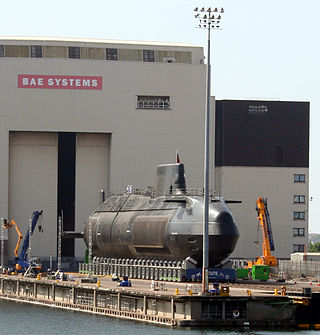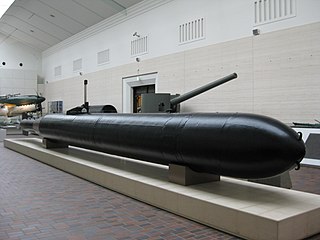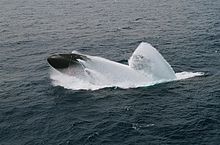
A submarine is a watercraft capable of independent operation underwater. It differs from a submersible, which has more limited underwater capability. The term is also sometimes used historically or colloquially to refer to remotely operated vehicles and robots, as well as medium-sized or smaller vessels, such as the midget submarine and the wet sub. Submarines are referred to as boats rather than ships irrespective of their size.

USS Thresher (SSN-593) was the lead boat of her class of nuclear-powered attack submarines in the United States Navy. She was the U.S. Navy's second submarine to be named after the thresher shark.

USS Greenling (SSN-614) was a Permit-class submarine. She was the second ship of the United States Navy to be named for the greenling, an elongated, fine-scaled fish found from Kamchatka to California. Her keel was laid down on 15 August 1961 by General Dynamics Electric Boat of Groton, Connecticut.

USS Scorpion (SSN-589) was a Skipjack-class nuclear-powered submarine that served in the United States Navy, and the sixth vessel, and second submarine, of the U.S. Navy to carry that name.

USS S-5 (SS-110) was a "Government-type" S-class submarine of the United States Navy. Her keel was laid down on 4 December 1917 by the Portsmouth Navy Yard of Kittery, Maine. She was launched on 10 November 1919, sponsored by Mrs. Glenn S. Burrell, and commissioned on 6 March 1920 with Lieutenant Commander Charles M. "Savvy" Cooke, Jr., in command. She sank accidentally during full-power trials on 1 September 1920, but due to actions by her crew and the crews of other ships, there were no deaths. Refloated, she was lost when she sank again while under tow on 3 September 1920.

The Permit-class submarine was a class of nuclear-powered fast attack submarines in service with the United States Navy from the early 1960s until 1996. They were a significant improvement on the Skipjack class, with greatly improved sonar, diving depth, and silencing. They were the forerunners of all subsequent US Navy SSN designs. They served from the 1960s through to the early 1990s, when they were decommissioned due to age. They were followed by the Sturgeon and Los Angeles classes.

A nuclear submarine is a submarine powered by a nuclear reactor, but not necessarily nuclear-armed. Nuclear submarines have considerable performance advantages over "conventional" submarines. Nuclear propulsion, being completely independent of air, frees the submarine from the need to surface frequently, as is necessary for conventional submarines. The large amount of power generated by a nuclear reactor allows nuclear submarines to operate at high speed for long periods, and the long interval between refuelings grants a range virtually unlimited, making the only limits on voyage times being imposed by such factors as the need to restock food or other consumables.

Kaiten were crewed torpedoes and suicide craft, used by the Imperial Japanese Navy in the final stages of World War II.

A diving bell is a rigid chamber used to transport divers from the surface to depth and back in open water, usually for the purpose of performing underwater work. The most common types are the open-bottomed wet bell and the closed bell, which can maintain an internal pressure greater than the external ambient. Diving bells are usually suspended by a cable, and lifted and lowered by a winch from a surface support platform. Unlike a submersible, the diving bell is not designed to move under the control of its occupants, or to operate independently of its launch and recovery system.
A crash dive is a maneuver by a submarine in which the vessel submerges as quickly as possible to avoid attack. Crash diving from the surface to avoid attack has been largely rendered obsolete with the advent of nuclear-powered submarines, as they normally operate submerged. However, the crash dive is also a standard maneuver to avoid a collision.

USS Von Steuben (SSBN-632), a James Madison-class fleet ballistic missile submarine, was the second ship of the United States Navy to be named for Baron Friedrich Wilhelm von Steuben (1730–1794), a Prussian army officer who served in the American Revolutionary War.

K-429 was a Project 670-A Скат nuclear submarine of the Soviet Navy. Her keel was laid down on 26 January 1971 at Krasnoye Sormovo in Gorky. She was launched on 22 April 1972, and was commissioned on 31 October 1972 into the Soviet Pacific Fleet.

A ballast tank is a compartment within a boat, ship or other floating structure that holds water, which is used as ballast to provide hydrostatic stability for a vessel, to reduce or control buoyancy, as in a submarine, to correct trim or list, to provide a more even load distribution along the hull to reduce structural hogging or sagging stresses, or to increase draft, as in a semi-submersible vessel or platform, or a SWATH, to improve seakeeping. Using water in a tank provides easier weight adjustment than the stone or iron ballast used in older vessels, and makes it easy for the crew to reduce a vessel's draft when it enters shallower water, by temporarily pumping out ballast. Airships use ballast tanks mainly to control buoyancy and correct trim.
The Submarine Safety Program (SUBSAFE) is a quality assurance program of the United States Navy designed to maintain the safety of its submarine fleet, specifically, to provide maximum reasonable assurance that submarine hulls will stay watertight, and that they can recover from unanticipated flooding.

A submarine hull has two major components, the light hull and the pressure hull. The light hull of a submarine is the outer non-watertight hull which provides a hydrodynamically efficient shape. The pressure hull is the inner hull of a submarine that maintains structural integrity with the difference between outside and inside pressure at depth.

A Kingston valve is a type of valve fitted in the bottom of a ship's plating that connects the sea to the ship's piping and storage tanks.

Saddle tanks are a type of ballast tank configuration fitted to submarines.

The McCann Submarine Rescue Chamber is a device for rescuing submariners from a submarine that is unable to surface.
A variable-buoyancy pressure vessel system is a type of rigid buoyancy control device for diving systems that retains a constant volume and varies its density by changing the weight (mass) of the contents, either by moving the ambient fluid into and out of a rigid pressure vessel, or by moving a stored liquid between internal and external variable-volume containers. A pressure vessel is used to withstand the hydrostatic pressure of the underwater environment. A variable-buoyancy pressure vessel can have an internal pressure greater or less than ambient pressure, and the pressure difference can vary from positive to negative within the operational depth range, or remain either positive or negative throughout the pressure range, depending on design choices.
Submarine rescue is the process of locating a sunk submarine with survivors on board, and bringing the survivors to safety. This may be done by recovering the vessel to the surface first, or by transferring the trapped personnel to a rescue bell or deep-submergence rescue vehicle to bring them to the surface. Submarine rescue may be done at pressures between ambient at depth, and sea level atmospheric pressure, depending on the condition of the distressed vessel and the equipment used for the rescue. Self-rescue of submarine personnel by buoyant free ascent at ambient pressure is considered submarine escape. Survivors may require recompression treatment for decompression illness.















